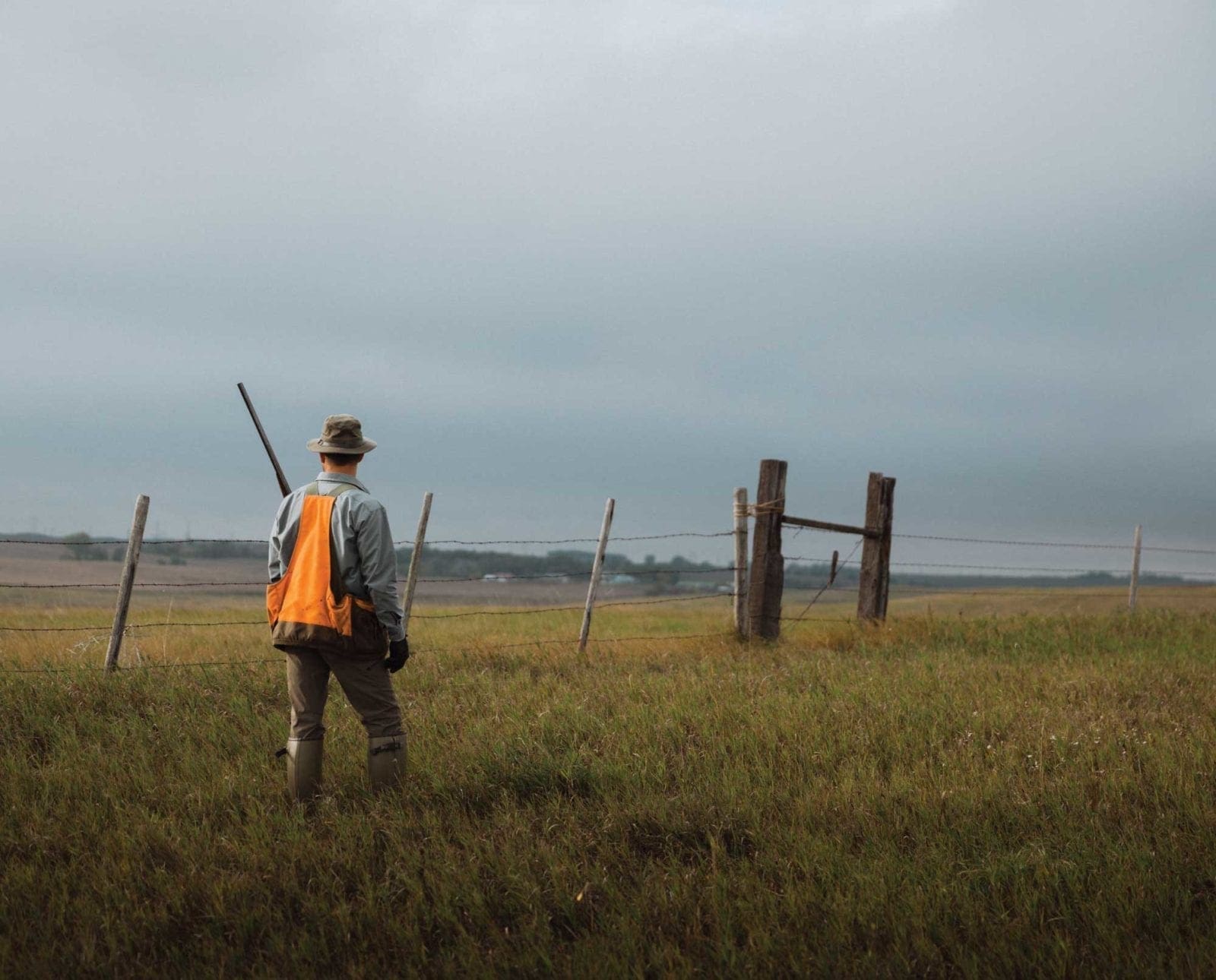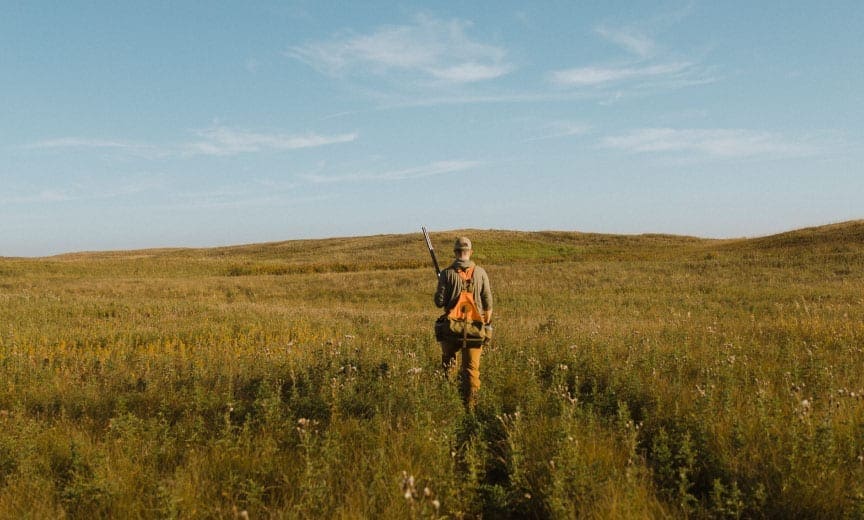Home » Grouse Species » Sharp-tailed Grouse Hunting » Finding Sharp-Tailed Grouse Habitat
Finding Sharp-Tailed Grouse Habitat

Ryan Lisson is a biologist and regular content contributor to…
Breaking down and exploring sharp-tailed grouse habitat for newbies
The sharp-tailed grouse is one seriously charismatic bird. If you’ve ever seen videos of sharp-tails doing their telltale dancing competitions, you were likely hooked immediately. They are fascinating birds to watch and to hunt. Furthermore, the open habitats they live in are equally beautiful and captivating in their own way. If you’ve never had the chance to explore these areas and hunt sharp-tailed grouse, here’s a description of their primary habitat type and how you can learn to spot a few key features while afield.
Sharp-tailed grouse habitat
First things first: the sharp-tailed grouse is a member of the prairie grouse species. Like their distant cousins, prairie chickens, prairie grouse require grasslands and open areas with very little tree cover in order to thrive. Sharp-tailed grouse prefer either open grassland habitat or short brushland habitat with no more than the occasional small copse of trees. To find such unbroken habitat, you need to travel to the northern prairie states, including Montana, Wyoming, the Dakotas, Nebraska, and parts of northwest Minnesota. Alaska and Canada also hold abundant populations of these birds.

Important fall habitat features
While sharp-tailed grouse use slightly different habitats throughout the year, there are a few important habitat features you can count on for fall hunting seasons. Seek these out and you should find a few coveys to keep your hunting dogs interested.
- Open Areas. This is a must for sharp-tailed grouse throughout the year. During the fall, the birds use grassland/prairie cover, old fields, sedge meadows, open bogs, and shorter brushlands to hide from predators and protect themselves from the elements. Without this base cover in the region, the birds will be hard to find.
- Food. While grasslands and Conservation Reserve Program (CRP) plantings provide great shelter habitat for sharp-tailed grouse, agricultural fields can provide a lot of food resources too, as long as it is a minor component in the general area. Sharp-tailed grouse will happily consume waste grain, including cereal grains (e.g., wheat, oats, and rye), buckwheat, and corn, as well as insects like grasshoppers. In more remote areas, scattered clumps of shrubs and trees can provide food resources, including catkins/buds (e.g., aspen, willow, birch, serviceberry, chokecherry, etc.) or fruits and berries (e.g., hawthorn, wild plum, rose hips, buffalo berry, snowberry, etc.).
- Water Sources. Most upland birds don’t need a lot of water to satisfy their needs, but it is still an important feature. Particularly if the area you’re hunting has been under a drought, seek out water sources to find the birds. Field ditches, brushy draws, old stream corridors, sloughs, and prairie potholes can all hold enough water to attract some sharp-tailed grouse, especially if there is also food and cover nearby. In the fall, look for green vegetation in these depressions, and you will likely find some water.
- Lek Sites. Lekking is when males get together to put on competitive displays for female attention and breeding rights. Sharptail leks usually occur in short grass prairies or closely cropped vegetation. While leks play a much more important role during the spring breeding season, sharp-tailed grouse tend to stick fairly close to these sites throughout the year. Since lek sites tend to persist year after year, it can be a huge advantage to know where a few lek sites are located. Ethically, you shouldn’t hunt right on or adjacent to a known lek site (and there may be special legal provisions about this anyway). But as a first time sharp-tail hunter, if you draw a circle a couple miles around a lek site, you should be able to flush a few grouse on public lands within this area.

Identify sharp-tailed grouse habitat while hunting
Start your sharp-tail hunt by scouting as much as you can. Find a good vantage point overlooking transition areas between agricultural fields (feeding area) and grassland cover (roosting and loafing area). If you’re in the right place, you should see some birds flying between the two areas around daybreak. This will give you a good idea of where you can focus your hunting efforts and limit the walking to high potential areas. Unless you’re looking for some exercise…then feel free to pick a direction and go exploring.
Where to find early-season sharp-tailed grouse
In the early season, sharptails are likely to gather in larger flocks of up to a couple dozen in very open country. These birds like an open view so they can see what’s coming at them. They may even loaf around during the day in sparse grass cover that’s only 4 to 8 inches tall or even grain stubble. As a result, it can be tough to sneak up on them in the early part of the year as they’ll flush well ahead of you. But in large flocks, there are likely to be a few stragglers that will hold tight, so be prepared for a shot. Pay attention to where they land and attempt another flush, as many sharp-tails seem to hold better the second time around.
Start a morning hunt by walking through or around the food. If you can get access to hunt private land where wheat fields are located adjacent to public grassland cover, you have a good chance at encountering some birds. While working your way into the wind, try doing a weaving pattern cross-wind to intercept more birds and give your dogs a good chance to scent them. As the day wears on, transition back into the grasslands, focusing on hillsides with vantage points around them. If it’s a particularly dry and hot afternoon, seek out any water features for a better chance at flushing some birds. If you still have the stamina and an empty hunting vest at the end of the day, try walking the field edge between food and grass again.
Where to find late-season sharp-tailed grouse
Later in the season, coveys tend to get smaller and more dispersed, and they tend to change their habits a little as well. While food will still be important, a lot of the waste grain may be gone in private fields, particularly if farmers till it under in the fall. Native plant food sources become more important at this time, so focus more on low shrubs and riparian corridors where catkins, buds, and fruits/berries will be more available. During the day, they may also forfeit some of their views for better security from the weather and predators, and so you will find them hiding in denser/taller grass cover, windbreaks, or shrub clumps. If there’s snow on the ground, keep an eye out for tracks that may indicate birds nearby.
If you’ve never tried hunting sharp-tailed grouse before, you might want to consider a road trip to the prairie this season. In many cases, you can also hunt prairie chickens, Hungarian partridge, sage grouse, and quail in these same areas, so a trip is easily justified. Use these tips to locate general sharptail habitat and then home in on key habitat features for the best chance of flushing some birds. If nothing else, a walk through the prairie is never a waste of time.
Ryan Lisson is a biologist and regular content contributor to several outdoor manufacturers, hunting shows, publications, and blogs. He is an avid small game, turkey, and whitetail hunter from northern Minnesota and loves managing habitat almost as much as hunting. Ryan is also passionate about helping other adults experience the outdoors for their first time, which spurred him to launch Zero to Hunt, a website devoted to mentoring new hunters.




I live in Michigan’s lower peninsula they say we have a few Sharptails in the Upper Peninsula you know anything about them???